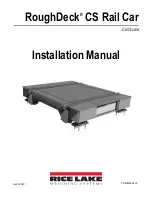
RoughDeck CS Rail Car Coil Scale
10
Visit our website
6.0
Troubleshooting
If the system powers up and give some type of stable digital readout that varies with the load on the systems, any system
problems are probably caused by factors other than load cells. The load cells are often blamed for a malfunctioning system, but
the majority of the time, the problems exists elsewhere. Look for mechanical causes for your problem first.
If the system can be calibrated but doesn’t return to zero, loses calibration or demonstrates non-linearity or non-repeatability,
see
for possible causes and do the following checks.
1. Check the load cell mount for debris restricting load cell movement or debris between the scale and structure.
2. Check that tank/vessel and mounts are plumb, level and square at the critical areas.
3. Check all piping and conduit for connections that restrict movement.
4. If check rods are used, loosen all connections to finger tightening only for testing.
5. Check load cell cables for physical or water damage.
If, after all these checks, the problems still cannot be isolated, reconnect all but one load cell. Replace the load cell with a load
cell simulator. Alternate so that each load cell is individually disconnected and replaced with a simulator. If there is a problem
with a particular load cell, the system should disappear when that load cell is disconnected and replaced with the simulator.
Symptom
Possible Cause
No return to zero
Mechanical binding or debris in the seals or under load cells; may have lost system calibration
Non-linearity
Thermal expansion or deflection under the load causing binding or side load
Non-repeatability
Loose load cell mount; drifting caused by moisture, load cell overload or shock damage;
mechanical binding
Lost calibration
Out of level or plumb; moisture problem; mechanical binding
Drifting readout
Moisture in junction box, cables or load cell; mechanical binding
Table 6-1. Troubleshooting




































